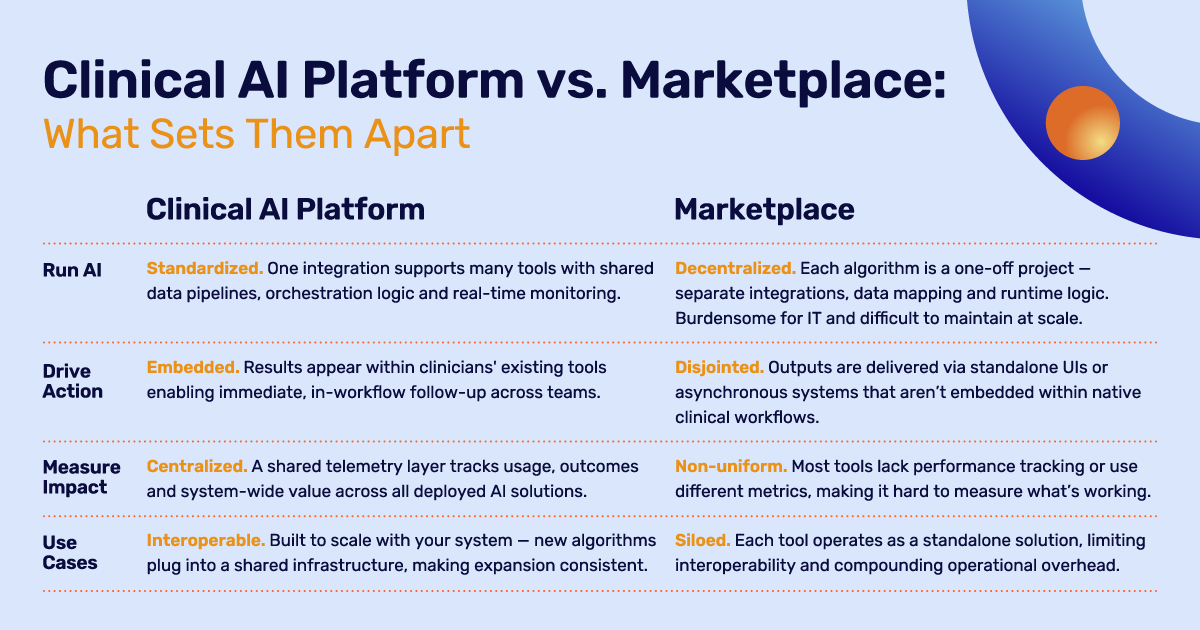Successfully implementing clinical AI can reshape the trajectory of a health system — improving margins, energizing staff and accelerating better outcomes — but when done poorly, it risks becoming just another overpromised solution that fails to deliver meaningful change.
Nowhere is that risk more evident than in the common confusion between AI platforms and AI marketplaces. On the surface, they can sound similar. Both promise scale. Both claim integration. However, beneath the marketing language are critical differences that shape how AI is deployed, governed and scaled.
Understanding those differences isn’t just a technical distinction; it’s a strategic one. In this post, we evaluate what sets platforms and marketplaces apart, why confusion between the two persists and what’s at stake when health systems bet on the wrong AI integration approach.
A true clinical AI platform is an end-to-end, integrated system where AI isn’t just layered on top of workflows — it’s embedded at every level. Algorithms run natively within the infrastructure, continuously analyzing data at scale. Outputs aren’t only actionable but also measurable, with real-time feedback loops that quantify impact and drive ongoing optimization across clinical, operational and financial metrics.
A clinical AI platform provides four essential functions:
- Run AI (Standardized): Ingest and normalize messy data, orchestrate logic and monitor performance in real-time.
- Drive Action (Embedded): Deliver results through clinician-friendly interfaces integrated into native systems and connected across domains. For example, linking a radiology workstation to a mobile app or care coordination tool to ensure timely follow-through.
- Measure Impact (Centralized): Track engagement, clinical outcomes and system-wide value through a shared telemetry layer.
- Use Cases (Interoperable): Offer a growing catalog of AI applications that are deployed within a unified, scalable infrastructure.
Without the first three layers, AI can’t operate effectively at scale, and that’s where platforms stand apart.
What’s a Marketplace?
A marketplace is a curated catalog of third-party AI tools, offering access to dozens of algorithms in one place. While this model offers breadth, it lacks the infrastructure to support enterprise-grade deployment at scale.
A marketplace typically introduces four key challenges:
- Run AI (Decentralized): Each algorithm requires its own integration pathway, data mapping, orchestration logic and runtime environment, with no unified way to manage smart orchestration during deployment or monitor performance afterward. This places a heavy burden on IT teams, making it difficult to deploy and maintain multiple AI solutions at scale. As a result, sites struggle to ensure consistent algorithm performance, reducing clinical impact and leading to missed opportunities to identify at-risk patients.
- Drive Action (Disjointed): Outputs are delivered via standalone UIs or asynchronous systems that aren’t embedded within native clinical workflows.
- Measure Impact (Non-Uniform): Without a shared telemetry layer or deep system integration, most marketplaces lack the ability to measure the impact of a single algorithm — making it nearly impossible to track real usage, evaluate performance or demonstrate outcomes in a consistent, clinically meaningful way.
- Use Cases (Siloed): Algorithms are deployed as point solutions with no shared services layer, limiting interoperability and compounding operational overhead.
Without platform-level cohesion, marketplaces can place heavy burdens on IT, disrupt clinical workflows and inhibit system-wide adoption.
Why Are the Two Approaches Confused?
From the outside, platforms and marketplaces can appear similar. Both promise access to multiple AI solutions, but the similarities stop at the surface. The underlying infrastructure, workflow integration and clinical usability are fundamentally different.
This confusion often stems from limited real-world experience. For health systems just beginning their AI journey, a large algorithm catalog can seem like the fastest path to scale. However, what’s often missed is the operational complexity: each solution requires its own integration, user interface and workflow governance and clinician training — none of which scales easily.
The single biggest difference? A platform centralizes AI execution, action and oversight, while a marketplace externalizes it. One is built to scale with your health system. The other asks your health system to scale around it.
Health systems may think: “We’ll need AI for radiology, cardiology and Emergency Department (ED) triage, why not choose a marketplace with it all?”
The problem is that most marketplaces lack both the infrastructure to scale and the tools to run AI intelligently. Each algorithm often requires its own integration, security review, legal agreement and workflow design, which limits rollout to just one or two tools per year.
Even after deployment, performance suffers. Without smart orchestration, algorithms don’t run optimally on real-world data, leading to inconsistent results and reduced clinical impact — identifying fewer patients than they should.
Usability is another challenge. Clinicians may need to switch between interfaces, interpret outputs delivered on different timelines or search for results outside of their native systems. This introduces friction instead of efficiency.
Then there’s the final challenge: impact. Without a consistent way to measure outcomes across tools, health systems have no clear view of what’s working, what’s not or where to optimize.
By contrast, a true clinical AI platform enables health systems to deploy and scale dozens of applications through a single, unified infrastructure, making AI easier to adopt, govern and scale.
How to Evaluate a Partner
Confusing a marketplace for a platform isn’t just a technical misstep — it’s a strategic one. The consequences ripple across clinical, operational and financial performance. That’s why it’s critical to look beyond surface-level claims and dig into what the underlying technology actually delivers.
If you’re evaluating AI for your health system, don’t just count algorithms. Ask what’s underneath:
- How many algorithms can I realistically deploy in 12 months?
- How much IT effort will that require?
- Do I have a single point of contact for both integration and ongoing support?
- How are these algorithms integrated into clinical workflows — and is that workflow consistent across all clinicians?
- Who owns the configuration and clinical delivery of each tool?
- Can we measure impact consistently across the system?
Platforms aren’t just more usable — they’re more scalable, more measurable and more clinically sustainable. And that makes all the difference when you’re betting on enterprise-wide AI.





